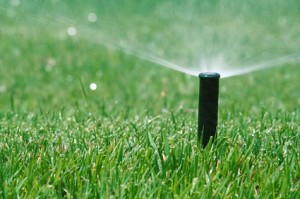The Latest Lawn Irrigation Sprinkler Systems

Homeowners, particularly those who live in the dry western United States, are increasingly aware of the scarcity of water. The latest sprinkler system and lawn irrigation designs are all about maximizing water usage and minimizing waste or runoff. Lawn sprinkler designs involve careful timing to avoid watering during rain showers. Many of them also incorporate drip irrigation systems for trees, vegetable gardens and other thirsty yard areas.
For an ideal lawn sprinkler design, it is important to understand your water supply and climate, and the size, shape and composition of your yard.
Water Supply
Before starting your lawn sprinkler design, determine your home's water pressure, water meter size and water flow. If you’re using well water or another type of pumped water, determine the capacity of the pump. Intricate lawn irrigation design won’t help if you don’t have enough water to irrigate.
You can calculate the water pressure with a pressure gauge (after ensuring that no water is running inside or outside the house) or call your water company. The water meter size should be marked on the meter. Calculate the water flow by timing how long it takes to fill a 5-gallon bucket (but don’t throw out the water in the bucket). Divide 300 by the number of seconds it took to fill to calculate the flow in gallons per minute (GPM). The rule of thumb for lawn sprinkler design is 20 GPM per acre, so make sure there is enough water flow to maintain healthy grass with your lawn irrigation design.
Climate
Sprinkler systems in areas with freezing temperatures typically use polyethylene sprinkler tubing. In warmer climates, PVC may be a better choice. Also consider local watering regulations in setting the timers in your lawn sprinkler design.
Make sure you can easily adjust the timers every month based on weather patterns. This will maximize water savings in your lawn sprinkler design. Set your timers to run early in the cool morning hours before midday evaporation and avoid the plant diseases that can result from evening watering.
Measure Your Yard
A smart lawn sprinkler design must account for trees, landscaping, patios and other structures, and the need to keep water away from your home’s foundation. Measure the yard carefully and sketch out all the shrubs, tall plants or other features that could get in the way of sprinkler systems -- or have a landscaper take care of the project for you.
We recommend a lawn sprinkler design with sprinkler heads that rise up four inches above the lawn. That allows you to keep the grass taller without disrupting the sprinkler spray. Taller grass is also healthier and needs less water.
Steve Graham writes for networx.com.
Updated June 20, 2018.
Looking for a Pro? Call us (866) 441-6648

Landscaping Average Costs
Landscapers Experiences

Leaf Removal This Year, More Landscape Work Next Summer

Tree Removal For The Last Part Of A Poor Old Mulberry



